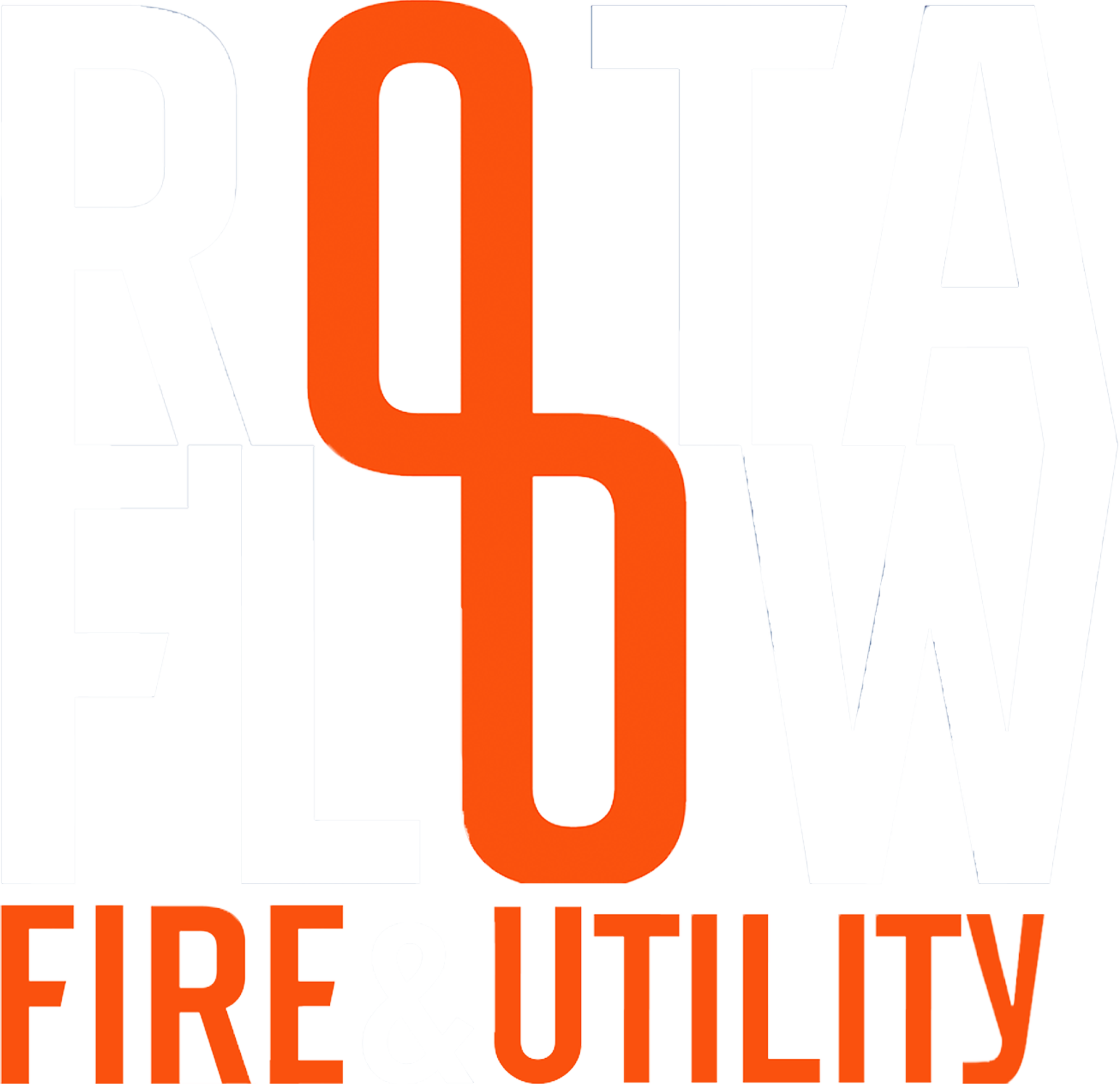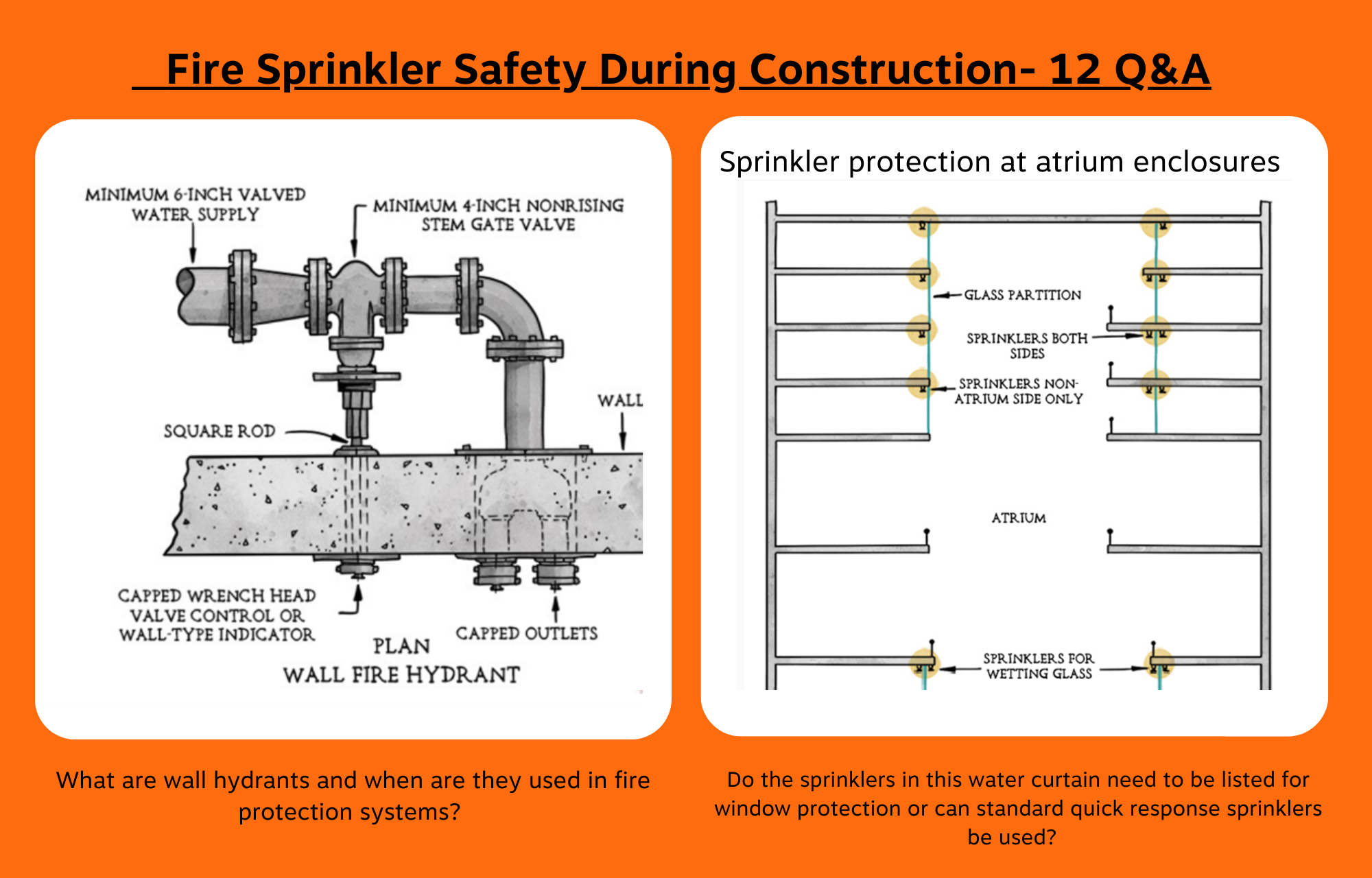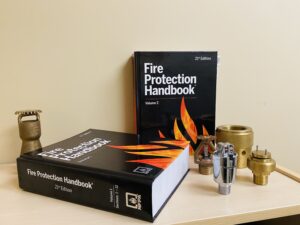Question #1 – Older sprinkler system C-values An existing fire sprinkler system is being calculated and the AHJ is requiring that a C-value of 100 be utilized due to the age of the system. The use of this lower C-value with require that the existing pipe be increased or that a fire pump be added. Is there any justification in NFPA 13 for this request?
Answer-
Actually, the C-values required by NFPA 13 presuppose that the plumbing is old. For instance, Table 27.2.4.8.1 of the 2019 version of NFPA 13 requires the use of a C-value of 120 when calculating black steel pipe in a wet pipe system (using the Hazen-Williams calculation), although the actual C-value of modern black steel pipe is 140. The Hazen Williams method already upscales the C-value by 16% to account for the piping’s aging.
It should be noted that while Table 27.2.4.8.1’s footnote does say that “The authority having jurisdiction is permitted to allow other C-values,” it does not say that the AHJ can compel the use of a different C value.
Additionally, if the water quality is known to be poor and the pipe deteriorates quicker than would be expected in typical water sources, further changes to the C-value may be necessary, as stated in the Automatic Sprinkler Systems Handbook – 2019 edition’s comments to Section 27.2.4.8. However, lowering the C-value from the recommended values shown in Table 27.2.4.8.1 without a justification would only impose an extra safety factor on the computations, which NFPA 13 does not mandate.
Question #2 – Floor mounted obstructions in ordinary hazard occupancies Sprinklers are being installed in a self-storage occupancy. The walls for the self-storage units do not go to the ceiling deck and the distance from the sprinkler deflector to the top of the wall is less than 18-inches. Figure 8.6.5.2.2 in the 2016 edition of NFPA 13 is limited to light hazard occupancies for floor mounted obstruction. In an ordinary hazard occupancy, do these walls (that do not extend to the ceiling deck) need to be treated as full height walls?
Indeed, only occupancies with light hazards are included by Figure 8.6.5.2.2. The partition wall would restrict the formation of the sprinkler discharge pattern since there is less than 18 inches between the top of the wall and the sprinkler deflector. The sprinklers should be positioned to the wall as if it were full height in an ordinary hazard occupancy as there is no special obstruction requirement for this circumstance, but a minimum spacing between sprinklers of 6 feet must be maintained or baffles must be installed.
Although Section 8.6.5.2.2 only applies to light hazard occupancies in the 2016 edition, it should be noted that modifications in the 2022 version will include obstruction requirements for floor mounted obstacles in regular hazard occupancies. If the sprinkler is situated within 6 inches of the obstruction’s centre line, the 2022 edition of NFPA 13 will permit the top of a partition to be at least 6 inches below the sprinkler deflector. Only partitions with a width of 12 inches or less will be subject to this requirement. The ensuing criteria are illustrated in the diagram below:
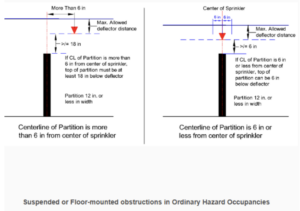
Question #3 – Temporary protection in buildings under construction The following questions were asked about temporary sprinkler protection during construction and are answered separately. Question #3-1: Does NFPA 241 require temporary sprinkler protection during construction? Question #3-2: Does NFPA 241 require a fire watch? Question #3-3: Is it the owner’s responsibility to provide the fire watch, unless delegated to an agent or qualified contractor ?
Answer 3-1: The 2019 edition of NFPA 241 does not provide for momentary sprinkler protection. According to Section 7.9, the use of temporary fire sprinkler protection certified by the AHJ shall be permitted (but is not required) as additional protection during construction, alteration, or destruction. If automated sprinkler protection is to be given, the system must be put into service as soon as is practical, according to section 8.7.3 for sprinkler protection. Temporary sprinkler protection during construction or alterations is not mandated by the standard.
Answer 3-2: As long as all of the safety measures outlined in NFPA 241 are taken, the 2019 edition of the code does not mandate a fire watch for unprotected, vacant construction sites that are divided from adjacent inhabited and protected areas by fire barriers. According to NFPA 51B, Section 5.1 mandates a fire watch that is exclusive to hot work. According to site security section 7.2.5, guard service must be offered when the relevant authority requests it. In cases when guard service is offered, the guard(s) must be educated in alerting the fire department and management people, using construction elevators where available, becoming familiar with fire threats, and operating fire protection equipment. Except as indicated for hot work processes, the standard has no requirements for a fire watch.
Answer 3-3: According to NFPA 241, 2019 edition, Section 7.2 for the owner’s obligation, the owner must name a person (fire protection programme manager) who will be in charge of the fire prevention programme and make sure it is carried out to the end. Where guard service is offered, the owner’s authorised fire prevention programme manager is in charge of the guard service.
If NFPA 241 or the International Fire Code (IFC) demand it, the owner must offer guard service. The development, implementation, and maintenance of an approved, written site safety plan establishing a fire prevention programme at the project site shall be the responsibility of the owner or the owner’s authorised agent, according to IFC, 2021 edition, Section 3303.1 for the owner’s responsibility for fire protection. According to Section 3303.2, the owner must appoint a person to serve as the site safety director, and in cases where guard service is offered, the site safety director is in charge of the guard service.
Question #4 – Underground velocities for NFPA 13D NFPA 13D does not seem to set a velocity limit on a combined fire sprinkler and domestic underground service however the data sheets for many backflow prevention devices do include a velocity limitation. Why does NFPA 13D not include a maximum flow velocity for combined underground service lines?
The NFPA 13, NFPA 13R, and NFPA 13D sprinkler installation standards do not specify a maximum velocity threshold. Some individuals claim that there should be a limit on the speed of water running through fire sprinkler systems for two reasons, although none of these arguments has any merit. Two issues that are frequently raised are:
Pipes and component deterioration: The pipe and fittings in plumbing and other systems that operate at high flow rates continuously may deteriorate over time. This is the rationale for the common velocity restriction seen in plumbing codes. Rarely do fire sprinkler systems—including NFPA 13D systems—experience system demand- or no-flow conditions. Only during a fire occurrence may an NFPA 13D fire sprinkler system encounter a high velocity flow. These fluxes are infrequent, and if they did occur, they would only last a brief time in the system. This proves that the worry about high-velocity wear and tear is unfounded. This is valid for NFPA 13D systems with pipes that also serve household or plumbing requirements (such as multipurpose systems or systems with a shared water service pipe). Although there may be a continual domestic flow via the pipes, a velocity restriction is not necessary since a fire event’s high velocity is an uncommon occurrence. For fire sprinkler systems, particularly residential systems constructed in compliance with NFPA 13D, the worry over pipe wear and tear due to high velocities is not a valid issue.
Hazen-Williams Calculations: The unfounded assumption that the Hazen-Williams method of computation is inaccurate at high velocities (exceeding 32 ft/sec) is another often claimed justification for restricting the velocity. The NFPA 13 committee examined this problem and came to the conclusion that a velocity restriction was not required. In NFPA 13 (2016), Section 23.4.1.4, it is stated as follows:
The velocity of water flow should not be restricted when hydraulic calculations are made using the Hazen-Williams or Darcy Weisbach formulae, unless otherwise specified by other NFPA rules.
This idea would still be applicable to NFPA 13D even if it does not contain a statement identical to that in that standard.
Answer- The same principles would apply for a velocity limitation for backflow preventors. A typical maximum system flow rate (generally 7.5 ft/sec) is frequently included in the data sheets for backflow preventers. The plumbing code and the previously described wear and tear idea serve as the foundation for this average maximum system flow rate. As previously noted, the uncommon or “surge” flows of an operational fire sprinkler system are not a problem for the “wear and tear” issue of the plumbing rules. Furthermore, the “typical maximum flow rate” shown in the data sheets is not the highest flow rate that the device is capable of handling, but rather is listed as a “typical” maximum flow rate to aid designers in choosing the proper pressure loss for the backflow device.
Question #5 – Open sprinkler deluge fittings The 2017 edition of NFPA 15 in Section 5.3.6.1 states that steel piping used in manual and open systems must be galvanized both internally and externally and Section 5.4.3 states that when galvanized pipe is used, then the fitting also must be galvanized but does not specify that it must be internally galvanized. In an open deluge system using galvanized pipe, can black steel fittings be used if that are painted?
Answer- No, galvanized pipe and fittings are necessary in the event of an open deluge system to fend against both internal and exterior corrosion. Section 5.3.6.1, which mandates that steel pipe used in manual and open systems be galvanised on both the exterior and interior surfaces, makes this obvious. The cause is that internal corrosion is more likely to occur in open systems than in closed ones. interior corrosion is more likely to occur in open systems than in closed or moist systems because the interior components of open systems are exposed to the atmosphere. Therefore, black steel, as opposed to galvanised steel, is permitted for water-filled steel pipe systems under Section 5.3.6.3.
Simply put, Section 5.4.3 states that the fittings must also be galvanised if the pipe is. The idea is that while Section 5.3.6.1 states that the open deluge system requires internally and outwardly galvanised pipe, the fittings must likewise be galvanised both internally and outside. Black steel fittings can only combat exterior corrosion by being painted.
Question #6 - Sprinkler protection at atrium enclosures The International Building Code in Section 404.6 includes an exception that allows a sprinkler water curtain in lieu of a 1-hr fire barrier. Do the sprinklers in this water curtain need to be listed for window protection or can standard quick response sprinklers be used?
Answer-
Standard or rapid response sprinklers are allowed under the IBC. IBC Section 404.6 specifically mandates “automatic sprinklers” to safeguard atrium glass in walls and doors. Any sprinkler with a connection or a bulb would be permitted under this.
The IBC or NPFA 13 do not stipulate that atrium glazing must be protected by window sprinklers that are expressly designated. In particular, Section 404.6 of the IBC states that atrium glass is exempt from fire rating requirements when sprinklered. When glazing is available and fire ratings are required for walls, special application sprinklers are needed, and Section 703.4 offers an equivalent. Although rapid response sprinklers would be necessary if the atrium space posed a light danger, NFPA 13 does permit ordinary spray sprinklers. Standard spray sprinklers are also permitted under Section 9.3.15 of the 2019 edition of NFPA 13, if the building code authorizes their installation.
Question #7 – Water duration for a storage occupancy A storage occupancy is to be protected with Control Mode Density Area (CMDA) sprinklers in combination with in-rack sprinklers in accordance with Chapter 25 of the 2019 edition of NFPA 13. For the required water supply requirements, Section 25.2.1.6 refers to Table 20.2.2.6 which would require a water supply duration of 120 minutes. As this system is to be electrically supervised and monitored, can the duration be reduced to 90 minutes as discussed in Section 19.3.3.1.3?
Answer- The water delivery times listed in Chapter 20 are particular to storage occupancies and storage design requirements, not to general water supply times. The specifications for water supply duration for storage applications are found in NFPA 13, 2019 edition, Section 20.12, and Table 20.12.2.6. For light, ordinary, and additional hazard occupancies, there is no provision for a storage occupancy and storage design criterion to shorten the water supply duration equal to that of Section 19.3.3.1.3.
Question #8 – CPVC hangers Section 9.2.3.4 in the 2016 edition of NFPA 13 has detailed requirements for unsupported lengths for steel and copper but does not mention CPVC piping. The CPVC manufacturer requirements for hangers includes pipe hanger requirements that differ from the requirements found in NFPA 13. Is there a mention in NFPA 13 that references the need to follow manufacturer requirements?
Answer- Yes, if a listed product is not installed in accordance with manufacturer’s instructions, the installation does not adhere to the listing of that equipment and is thus in violation of NFPA 13 regulations. This is accurate even if the installation guidelines exceed the strict NFPA 13 regulations. This idea is covered in Section 9.3.9.1.2 of the CPVC pipe specification, which stipulates that listed nonmetallic pipe must be installed in compliance with its listing requirements, which include the installation instructions.
Question #9 – Mixing of K-Factors On a project there is a branch line with primarily K-14 sprinklers. At the end of this branch line, the piping drops down below an obstruction to feed a K-5.6 sprinkler. Can sprinklers with different K-factors be on the same branchline?
On the same branchline, sprinklers with various K factors are acceptable. According to NFPA 13, 2016 edition, Section 23.4.4.9.2, mixing sprinklers with different K-factors by lowering the K-factor of adjacent sprinklers on the same branch line leading back to the main is not permitted unless the requirements of 23.4.4.9.3 or 23.4.4.9.4 are met. This is done to reduce sprinkler over discharge.
In order to minimize fire sprinkler excess discharge, the standard expressly prohibits combining sprinklers with various K-factors by lowering the K-factor of nearby sprinklers on the same branch line running back to the main. The standard allows sprinklers with varying K-factors on the same branch line, but only if they are installed in a way that minimizes sprinkler overflow for sprinklers that are closest to the water supply.
Question #10 – Exterior projection and combustible siding A project consists of a 3-story office building with combustible siding and noncombustible external projections (aluminum decks) and is to be protected in accordance with the 2016 edition of NFPA 13. Section 8.15.7.2 states that sprinklers are not required when the exterior projection in noncombustible but does not mention the construction material of the building itself. Are sprinklers required below a noncombustible external projection where the building has combustible siding?
Answer- The prescriptive standards of NFPA 13 do not mandate that these outside decks be covered. The decks are made of non-combustible materials, therefore they wouldn’t need to be covered unless combustibles were going to be kept underneath this projection (see Section 8.15.7.5), which is not the case. The protection demanded by Section 8.15.7 is purely dependent on how the outside projection is made, not on the type of finish used on the structure to which it is attached.
Question #11 – Wall hydrants- What are wall hydrants and when are they used in fire protection systems?
As a wall hydrant connection has several purposes, the word “wall hydrant” is sometimes misinterpreted. They serve as test headers, roof manifolds, and auxiliary outlets connections to feed the fire department with water.
These hydrants are often situated in private structures, and their proper usage during an emergency should be prepared for or inspected beforehand. Many structures might not have been built to sustain a sufficient fire hydrant flow without negatively impacting the rest of the building’s fire safety. It is also important to confirm the intended usage of a wall hydrant.
A wall hydrant must be hydraulically calculated for an outside hose allowance when it is designed as a component of the fire prevention system. At the connection to the primary water supply or private fire hydrant, the outside hose allowance must be added to the sprinkler demand, according to NFPA 13 Standard for the Installation of Sprinkler Systems Section 19.2.6.2* (2019). The annexe note A.19.2.6.2 clarifies further that, when a separate water supply is utilised to feed each, the demand for sprinklers need not be included to the demand for outside hoses.
Wall hydrants are mentioned in the NFPA 24 Standard for the Installation of Private Fire Mains and Their Appurtenances. The AHJ must be consulted on the required water supply, placement, and arrangement.
The NFPA 25 Standard for the Inspection, Testing, and Maintenance of Water-Based Fire Protection Systems contains requirements for wall hydrant inspection, testing, and maintenance.
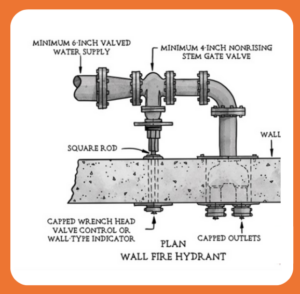
Question #12 – NFPA 150 Animal Housing - When is NFPA 150, Fire and Life Safety in Animal Housing Facilities Code required to be enforced?
Answer- The norms and standards set by the authority having jurisdiction (AHJ) shall be entirely responsible for this.
It would be necessary to enforce it if the AHJ adopts NFPA 150 outright.
Only the egress criteria of NFPA 150 must be used for animal housing facilities if the 2018 or more recent versions of NFPA 101 are implemented, according to Section 11.12.2. The sprinkler regulations would not be applicable in this case.
If the NFPA 5000 2018 or subsequent versions are adopted, Section 6.4.2.10 does mandate that animal housing facilities be built in line with NFPA 150 specifications. The criteria for sprinklers would be part of this. Finally, there are no requirements that NFPA 150 be used if the AHJ adopts the model I-Codes. Animal habitation facilities are not subject to the sprinkler regulations stated in Chapter 9 of the International Building Code.
It’s crucial to remember that the NFSA is now proposing to amend the 2024 model I-Codes’ absence of sprinkler requirements. The proposal outlines animal housing facilities and specifies the buildings’ sprinkler needs. However, the industry is collaborating with the committee to have NFPA 150 recognised in the I-Codes despite the idea being rejected during the committee action hearings in April.
Courtesy: Roland ASP, CET NFSA Technotes (Best of Aug 2021)
